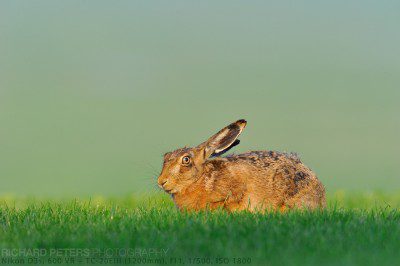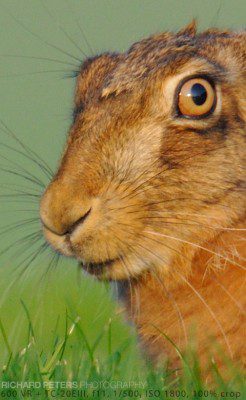When I originally picked up the TC-20EIII on release, I was keen to put it through it’s paces. Although it’s fair to say, it was more designed for use with the newer generation lenses that are only now starting to appear *2014 update*
Read on for my original thoughts…
I’ve recently got my hands on the Nikon TC-20EIII 2x teleconverter to see how it performs specifically on the 600 and 200-400 VR. There’s a full test in due course but here’s a quick sample image and 100%, unsharpened, crop of my first time using it out in the field. I’ve read quite a few hit and miss reports on this new version of the 2x Teleconverter with everyone raving about it’s performance on f2.8 lenses, but being a wildlife photographer I’m more interested in ultimate reach, so wanted to know how it performs on the larger f4 lenses. A quick call to Clifton Cameras and I had a copy of my very own to play with!
Back focus
Initially, after taking a couple of quick images and looking on the back of the camera, I thought this combo was ultra soft, as in, ‘why did they even make this thing?’ soft. However, I quickly realised this particular copy introduces severe back focus on my 600, 200-400 and 70-200, making autofocus unusable as the depth of field is always quite some way behind the point the focus locks on to. So far behind in fact, that Focus Fine Tune cannot compensate for it. Still, I headed out to find a subject to test on and this Hare played nicely.
This problem required manual focus to achieve anything remotely accurate, and on a subject that is twitching about eating grass thats not easy. My method was to use Live View, then zoom in to that image and manual focus to get it spot on – I think I got it pretty much where it needed to be, but it will be good to get a copy that doesn’t back focus so you can get constant micro-adjustment as the subject makes small movements. Because I couldn’t rely on autofocus I had to have my hand on the beanbag, with the lens resting on my hand so I could focus manually, so the actual lens itself was not touching the beanbag but did provide indirect support and I had VR on. There is no noise reduction but the shot is at ISO 1800 due to shooting at f11, which will have a small affect on clarity. Why am I telling you all this? Not to make excuses for the image quality, but to give you an idea of the conditions, as this was real world usage where lens performance really matters. I’d love to be shooting at ISO 200 on a full rock solid support but sometimes you don’t get that. And if you can’t make a lens combo work out in the field and work with what limitations you have, there’s no point in bothering. Even with better support and lower ISO I suspect however, there will be very little extra sharpness to be had here anyway – time will tell.

Click for 900 pixel wide version
Looks plenty sharp at 900 pixels web size right? Well, that’s easy. The real test is viewing it larger…
The crop
Opinions will vary here, as there are those out there that would rather not shot than anything less than a razor sharp image – after all, you spent money on some fine optics, so why degrade it? Me, I’m open to a little softness if it gets me a shot I otherwise wouldn’t be able to manage. Is this crops sharpness acceptable? Well, that’s for you to decide…

Click for 100% cropped section
Initial impressions on the 600 VR
Obviously it’s softer than the lens on it’s own, but oddly, sharper than I was expecting given it was on an f4 lens and taking me from 600mm to 1200mm (I’ve seen softer optics from some bare naked telephoto lenses!). And remember you are looking at a full res crop here with no sharpening, which equates to a pretty large print! Sit back a little, or download it to your computer, scale it down and add some sharpening and it’s not as awful as you may of at first thought. Viewed at 50% size on my 24″ screen it looks as sharp as any other image I’ve got. Sure I’d much rather use the lens without it but for those times when you absolutely cannot get closer, I think it might just save the day. For example with this Hare, I was at the limit of how close I could get without spooking it and making it run. If I didn’t have the TC on, I’d be looking at a huge crop. Focus is slow, and it can loose track if the light is anything less than perfect, but when it has a subject locked on it does stick with it (within reason). But I suspect it will only really be good for fairly static subjects. 1200mm is a lot of focal length, so long lens technique will be important and lets not forget atmospheric distortion trying to get in the way too, so this won’t be a combo you can just casually point and shoot with.
Full test and review coming soon
I’m undecided right now but I certainly won’t be writing it off just yet based on my first in the field image, but potentially, I could see myself using in the right conditions. But like I said I’m going to get another copy to hopefully sort out the back focus, and do some further field testing and also do some controlled tests, to compare it against the TC-17EII at several focal lengths, distances from subject and apertures on the 600 and 200-400. Normally I’m not a huge controlled test fan, but shooting wildlife means I can’t realistically do a fair direct comparison out in the field. There is lots of talk online about how good it is on the 70-200 but I’m more interested in the f4 telephoto stuff for wildlife, so that’s what I’ll be testing it on. I’ll be checking several key focal lengths at several key apertures and then putting the results side by side.
Watch this space…








